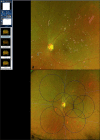The relationship of diabetic retinopathy severity scales with frequency and surface area of diabetic retinopathy lesions
- PMID: 37392262
- PMCID: PMC10587246
- DOI: 10.1007/s00417-023-06145-7
The relationship of diabetic retinopathy severity scales with frequency and surface area of diabetic retinopathy lesions
Abstract
Purpose: To assess the relationship between qualitative diabetic retinopathy (DR) scales with the precise numbers and surface area of DR lesions within the Early Treatment Diabetic Retinopathy Study (ETDRS) standard seven field (S7F) region on ultrawide-field (UWF) color fundus images.
Methods: In this study, we collected UWF images from adult patients with diabetes. Poor-quality images and eyes with any pathology precluding assessment of DR severity were excluded. The DR lesions were manually segmented. DR severity was graded according to the International Clinical Diabetic Retinopathy (ICDR) and AA protocol by two masked graders within the ETDRS S7F. These lesions' numbers and surface area were computed and correlated against the DR scores using the Kruskal-Wallis H test. Cohen's Kappa was performed to determine the agreement between two graders.
Results: One thousand five hundred and twenty eyes of 869 patients (294 females, 756 right eyes) with a mean age of 58.7 years were included. 47.4% were graded as no DR, 2.2% as mild non-proliferative DR (NPDR), 24.0% as moderate NPDR, 6.3% as severe NPDR, and 20.1% as proliferative DR (PDR). The area and number of DR lesions generally increased as the ICDR level increased up to severe NPDR, but decreased from severe NPDR to PDR. There was perfect intergrader agreement on the DR severity.
Conclusion: A quantitative approach reveals that DR lesions' number and area generally correlate with ICDR-based categorical DR severity levels with an increasing trend in the number and area of DR lesions from mild to severe NPDR and a decrease from severe NPDR to PDR.
Keywords: Diabetic retinopathy; ETDRS; ICDR; NPDR; PDR; Protocol AA.
© 2023. The Author(s).
Conflict of interest statement
SriniVas Sadda- although the co-author is the editor of the journal, there was no involvement with the peer review process for this article.
Figures




